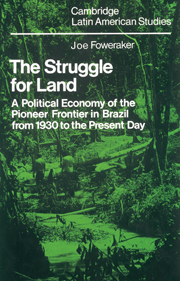 The Struggle for Land
The Struggle for Land Book contents
- Frontmatter
- Contents
- List of maps
- Preface
- Glossary of acronyms and abbreviations used in the text
- Glossary of words and phrases in Portuguese used in the text
- 1 Brazil: political and administrative divisions
- 2 Principal frontier regions
- 3 West Paraná: estates and municipalities
- 4 South Pará
- 5 South Mato Grosso
- Part 1 The pioneer frontier
- 1 The pioneer frontier; political violence and the peasantry
- 2 The process and stages of occupation of land on the frontier
- 3 Frontier expansion and the national economy
- Part 2 Political mediation
- Part 3 Accumulation and authoritarianism
- Bibliography
- Index
- CAMBRIDGE LATIN AMERICAN STUDIES
3 - Frontier expansion and the national economy
Published online by Cambridge University Press: 29 October 2009
- Frontmatter
- Contents
- List of maps
- Preface
- Glossary of acronyms and abbreviations used in the text
- Glossary of words and phrases in Portuguese used in the text
- 1 Brazil: political and administrative divisions
- 2 Principal frontier regions
- 3 West Paraná: estates and municipalities
- 4 South Pará
- 5 South Mato Grosso
- Part 1 The pioneer frontier
- 1 The pioneer frontier; political violence and the peasantry
- 2 The process and stages of occupation of land on the frontier
- 3 Frontier expansion and the national economy
- Part 2 Political mediation
- Part 3 Accumulation and authoritarianism
- Bibliography
- Index
- CAMBRIDGE LATIN AMERICAN STUDIES
Summary
Frontier expansion was interpreted in the last chapter as a process of integration into the national economy. This integration was seen to proceed through interrelated changes in both production and market relations: the integration which occurs through the progressive change to commercial production in response to the national market is simultaneously a transition from non-capitalist to capitalist production. This interpretation illuminates the process itself, but does not yet pose the question of the relationship between frontier and national economy; in effect, it suggests what occurs in frontier expansion but not why it occurs. Nevertheless, in proceeding to answer this latter question, it is apparent that the prior investigation of the process has revealed the principal dimensions of the determining structure – at least in the economic realm. Thus the question of the relationship between frontier and national economy is made two-fold: on the one hand, what are the production and property relations which determine frontier expansion and accumulation; on the other, what are the market relations which determine the transfer of value from frontier to national economy? In no sense are either or both sets of relations, which in the reality are not easily separated, to be taken as uniquely ‘determining’: their separate investigation here is simply intended as one step in the presentation of the political economy of the frontier.
This step aims to establish the structural conditions of frontier expansion, and so rejects any idea of ‘natural or ideal determination’ of the process.
- Type
- Chapter
- Information
- The Struggle for LandA Political Economy of the Pioneer Frontier in Brazil from 1930 to the Present Day, pp. 58 - 80Publisher: Cambridge University PressPrint publication year: 1981
